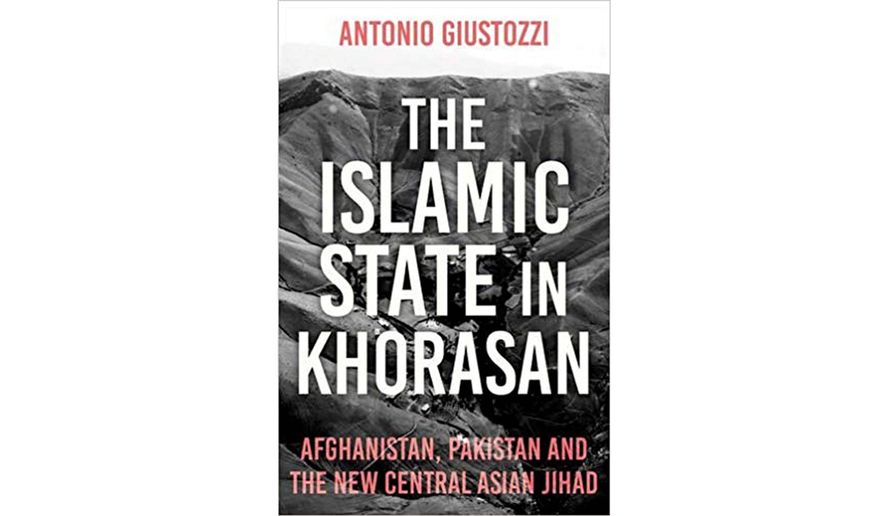OPINION:
THE ISLAMIC STATE IN KHORASAN: AFGHANISTAN, PAKISTAN AND THE NEW CENTRAL ASIAN JIHAD
By Antonio Giustozzi
Hurst & Company, $50, 296 pages
Last July 29, five terrorists in Tajikistan rammed a car into a group of seven Western cyclists and then attacked them with knives. Four of the killed cyclists included a couple from Washington, D.C., who were on a worldwide cycling adventure. The other fatalities were males from Switzerland and the Netherlands, and three others were wounded.
The Islamic State (also known as ISIS or ISIL) claimed responsibility for the attack, releasing a video showing the attackers pledging allegiance to the group. This was the first terrorist assault by local ISIS adherents against Western tourists in Tajikistan, who were part of the terrorist group’s regional branch, which is known as IS-Khorasan (IS-K).
As explained by Antonio Giustozzi in this important and extensively detailed account, the IS-K envisions Khorasan as the Islamic State’s regional caliphate, encompassing Afghanistan, Pakistan, Central Asia, Iran, parts of India and Russia. Even China is not immune, as an IS-K suicide bomber attacked the Chinese Embassy in Bishkek, Kyrgkystan, on Aug. 30, 2016, which was also intended to attract Chinese Uyghur jihadists to join its ranks.
The IS-K first emerged in Afghanistan in 2014 as part of the Islamic State’s ambition to overtake al Qaeda as the world’s pre-eminent jihadi terrorist group. Its core membership began as a small group of ISIS organizers and fighters who were dispatched to Afghanistan, but soon attracted disaffected fighters from the Taliban and other jihadist groups in Afghanistan and Pakistan, with other defections coming from other Central Asian groups, such as Uzbekistan’s Islamic Movement of Uzbekistan (IMU).
These disaffected jihadists, the author explains, regarded the IS-K’s ultra-extremist jihadist ideology as “more aligned with their uncompromising views,” for offering “higher salaries and better conditions and equipment,” and, above all, at least during its early years, for being part of the Islamic State’s successful control of territory in Iraq and Syria, which led to thousands of foreign fighters, with many of them from Western and Central Asian countries, as well as Chinese Uyghurs, to join ISIS’ ranks.
What makes the IS-K so dangerous today is that several thousand ISIS fighters who have recently been pushed out of Iraq and Syria, where ISIS has lost much of the territory previously under its control, have joined it in Afghanistan, whose anarchic rural areas make it easy for them to re-establish themselves in their safe havens.
Like ISIS in Syria and Iraq, the IS-K is ruthlessly brutal in its violent attacks, especially in targeting Afghanistan’s and Pakistan’s Shi’ite community. They hope such massacres and Shi’ite retaliations would polarize the majority Sunni populations’ hatred toward the Shia minorities and ignite large-scale sectarian warfare.
This would also further increase the IS-K’s popularity vis-a-vis the Taliban and al Qaeda, which generally attempt to avoid attacking Shi’ites, preferring to attack moderate Sunni adversaries within their own communities, such as government forces, educational institutions and humanitarian assistance organizations — whom the IS-K also attacks.
Also to the chagrin of the Taliban and al Qaeda, the IS-K has succeeded in exploiting Sunni-Shi’ite rivalry to gain Sunni Arab states’ support, with governments and wealthy citizens in countries such as Qatar and Saudi Arabia, favoring it over the Taliban, which is backed by their Shi’ite Iranian rival. It also exploits the antipathy toward the pro-Shi’ite Syrian government, which is backed by Iran and Russia.
As cited by the author’s IS-K source, the Qataris pushed the group to “open a new front in Central Asia,” with the rationale “a form of retaliation against Russia’s intervention in Syria, and an effort to force Russia to split its dwindling resource among several fronts. The assumption of the Qataris is clearly that the Central Asian states, if threatened, would request Russia’s assistance.”
Another factor in the IS-K’s success, the author points out, lies in its organizational structure. With an estimated several thousand fighters (exact figures are not known), it divides the territory where it operates in “Khorasan” into provinces, which are led by amirs (princes) who are responsible for administering its coercive version of religious laws, finance, logistics, recruitment and propaganda, and military operations.
With the IS-K’s attempt to clone IS-Central in its ultra-extremist Salafism, its centralized control over operations, and its brutal violence against its adversaries, the author concludes that its insurgency is flawed. It has failed “to forge the disparate groups that merged into it into a coherent whole,” it has continued to be dependent on external funding, which is drying up with the defeat of ISIS in Syria and Iraq, and it has failed to effectively “compete with the Taliban” in its insurgent warfare to replace it, thus becoming “a sideshow.”
Nevertheless, the IS-K’s rigid ideological extremism makes it a spoiler in preventing the Taliban from negotiating (however halfheartedly) with the Afghanistan government to resolve the insurgency, and it will continue to pose a threat in the “Khorasan” countries in which its terrorist operatives are present and are able to attract local recruits to its extremist cause.
Such insights, based on extensive regional-based research, make “The Islamic State in Khorasan” an important guide for understanding the magnitude of the threats posed by the IS-K in these highly volatile regions.
• Joshua Sinai is a senior analyst at Kiernan Group Holdings (KGH), in Alexandria, Va.




Please read our comment policy before commenting.